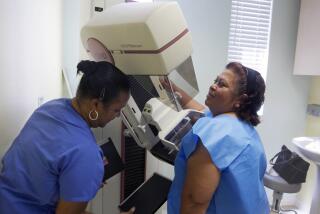More mammograms mean more problems for older women, study finds
- Share via
The American Cancer Society advises all women over 40 to get a mammogram once a year to screen for signs of breast cancer. The U.S. Preventive Services Task Force, a panel of experts that advises the federal government on health matters, says most women need to get mammograms only once every two years, and only when they’re between the ages of 50 and 74.
Who’s right? A new study comes down on the side of the task force.
Researchers examined records of about 140,000 women ages 66 to 89 who had mammograms between 1999 and 2006. Some of the women had mammograms every year, and some of them had them every other year.
It turned out that having annual mammograms did not reduce women’s risk of being diagnosed with an aggressive breast cancer, as might have been expected. When all the numbers were crunched, “the proportion [of women] with adverse tumor characteristics was similar among annual and biennial screeners,” the researchers wrote in a study published Tuesday by the Journal of the National Cancer Institute. Even when they accounted for factors like age, race and place of residence, they found no benefit to more frequent screenings.
But they did find harm. The more times that women were screened, the greater their odds of getting a false positive reading on a mammogram.
For example, among women between the ages of 66 and 74 who already had health problems, 48% of those who had annual mammograms had at least one false-positive reading during a 10-year period. But among those who were screened every other year, only 29% had a false-positive result.
And among women between the ages of 75 and 89 with preexisting health problems, 48.4% of those screened every year had at least one false-positive reading during a 10-year span, compared with only 27.4% of those who had less frequent tests.
The pattern was similar for women in both age groups who were in good health, according to the study.
“As is the case in younger women, most older women who undergo annual mammography are at high risk of false-positive mammography results and biopsy recommendations without added benefit from more frequent screening,” the researchers wrote.
If all American women in the 66-to-89 age group had mammograms every year instead of every other year, the result would be 3.86 million more false-positives and 1.15 million more recommendations for biopsies, they reported.
You can read a summary of the study online here.
Return to the Booster Shots blog.
Follow me on Twitter @LATkarenkaplan







